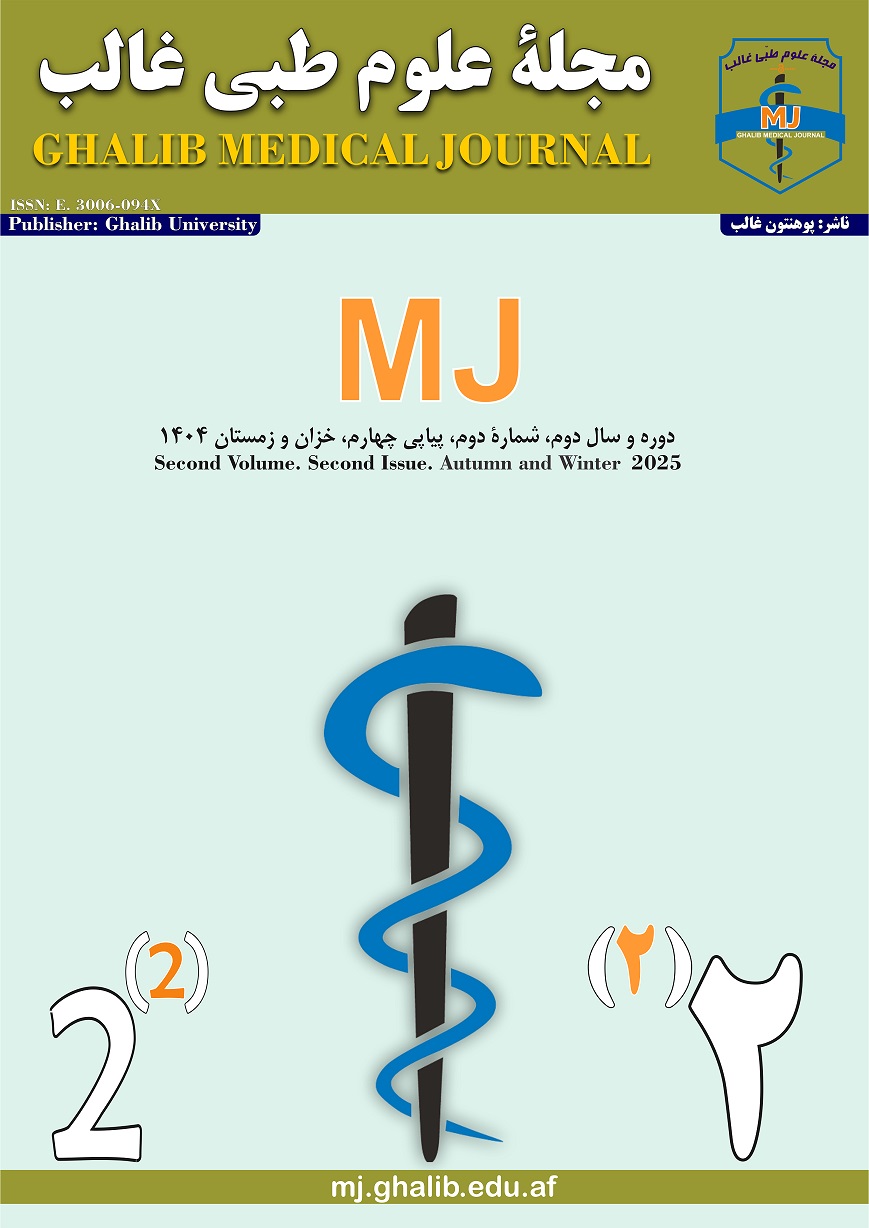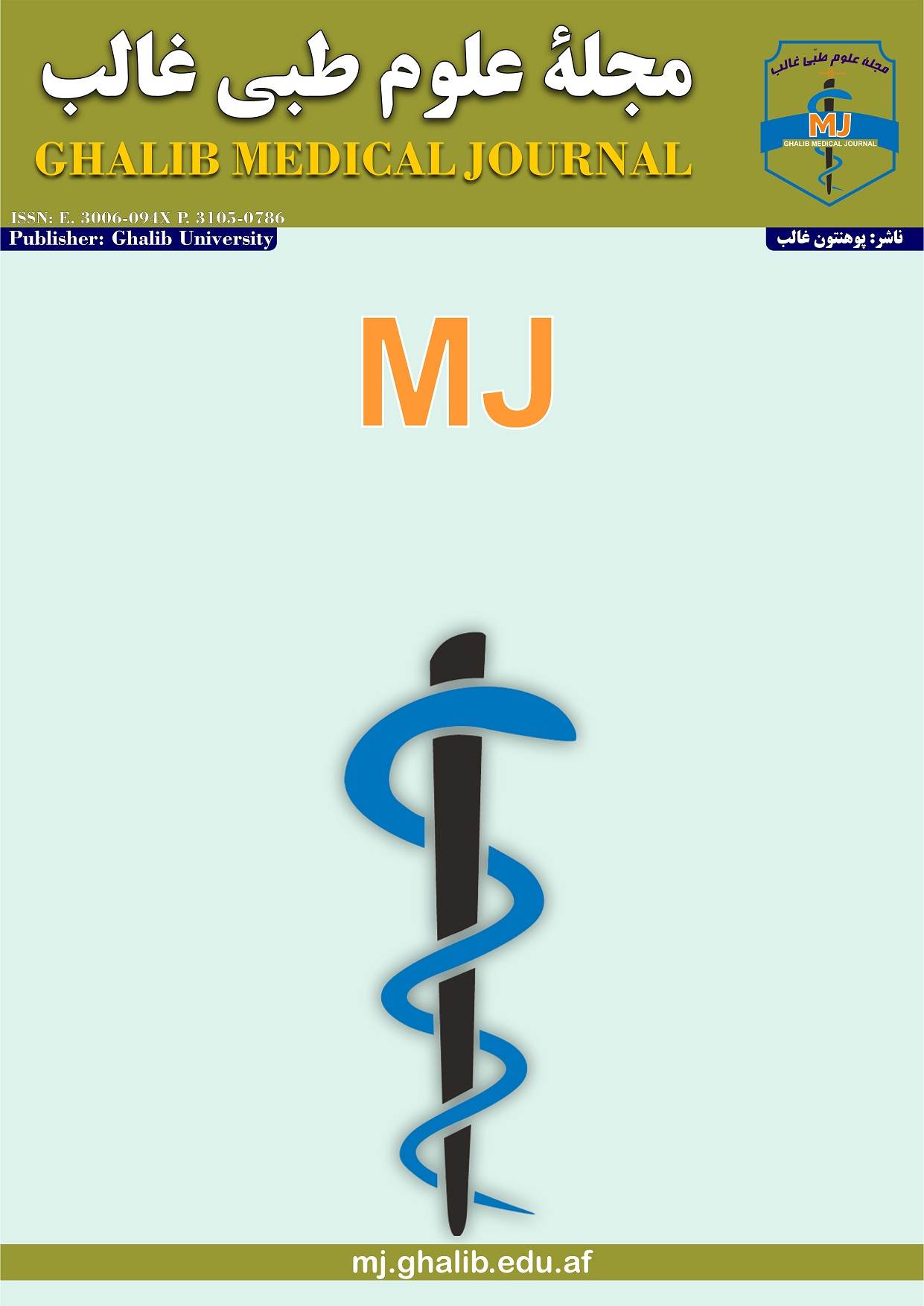A descriptive study of aluminum phosphide poisoning cases in Abu Ali Sinai Balkhi Reginal Hospital
DOI:
https://doi.org/10.58342/ghalibMj.V.2.I.2.5Keywords:
Supportive treatment, Aluminum phosphide poisoning, Mortality rate and recovered patients, Balkh Reginal hospitalAbstract
Background: Aluminum phosphide (AlP) is a highly toxic inorganic compound commercially known as Magic Phos or Celphide, widely used as a fumigant and rodenticide for protecting stored grains. Upon exposure to moisture, AlP releases phosphine gas (PH₃), a colorless, flammable, and highly toxic gas with a garlic or rotten fish odor. In many developing countries, including Afghanistan, AlP is increasingly used in suicide attempts due to its easy accessibility and high lethality.
Methods: To describe the demographic and clinical characteristics, presentation, and outcomes of patients with AlP poisoning admitted to the Internal Medicine Intensive Care Unit (ICU) of Abu Ali Sina Regional Teaching Hospital in Mazar-e-Sharif during the first eight months of 1403 (2024). This was a descriptive cross-sectional study based on a retrospective review of medical records of patients admitted with confirmed AlP poisoning. Data collected included patient age, gender, number and route of tablets consumed, presenting symptoms, and clinical outcomes.
Results: A total of 20 cases of AlP poisoning were recorded. Females accounted for 80% of the cases, with a mortality rate of 81.2%, while males accounted for 20%, with a 50% mortality rate. The majority of patients were under 25 years of age. Common clinical manifestations on admission included vomiting, abdominal pain, cyanosis, and shock. The most frequent cause of poisoning was intentional ingestion for suicide, responsible for 75% of deaths.
Conclusion: AlP poisoning remains a major public health concern due to its high fatality and the absence of a specific antidote. Supportive care is currently the only therapeutic option. Strict regulation of AlP availability, public education on its toxicity, and improved surveillance of its distribution may reduce the incidence and mortality associated with this form of poisoning in Afghanistan.
References
Hashemi-Domeneh, B., Zamani, N., Hassanian-Moghaddam, H., Rahimi, M., Shadnia, S., Erfantalab, P., & Ostadi, A. (2016). A review of aluminium phosphide poisoning and a flowchart to treat it. Archives of Industrial Hygiene and Toxicology, 67(3), 183–193. https://doi.org/10.1515/aiht-2016-67-2784
Torabi, M., Shahi Moridi, Z., & Mirziaee, M. (2023). The effect of intravenous lipid emulsion on the outcome of aluminium phosphide poisoning. Medical Journal of Tabriz University of Medical Sciences, 45(1). https://doi.org/10.34172/mj.2023.012
Sulaj, Z., Drishti, A., Çeko, I., Gashi, A., & Vyshka, G. (2015). Fatal aluminum phosphide poisonings in Tirana (Albania), 2009–2013. DARU Journal of Pharmaceutical Sciences, 23(8). https://doi.org/10.1186/s40199-015-0090-0
Rahimi, N., Abdolghaffari, A. H., Partoazar, A., Javadian, N., Dehpour, T., Mani, A. R., et al. (2018). Fresh red blood cells transfusion protects against aluminum phosphide-induced metabolic acidosis and mortality in rats. PLOS ONE, 13(3), e0193991. https://doi.org/10.1371/journal.pone.0193991
Khakpoornia, N., Mostafazadeh, B., Shadnia, S., Rahimi, M., Erfantalab Evini, P., & Ramezani, M. (2023). [Title missing]. Journal of Population Therapeutics & Clinical Pharmacology, 30(19). https://doi.org/10.53555/jptcp.v30i19.3990
Shafiee Dolat Abadi, S., Zamani, N., Abbasi, S., Shojaei, M., & Hassanian-Moghaddam, H. (2022). Neurologic sequelae of phosphide poisoning: A case report. Frontiers in Neurology, 13, Article 953645. https://doi.org/10.3389/fneur.2022.888493
Shadnia, S., Sasanian, G., Allami, P., Hosseini, A., Ranjbar, A., Amini-Shirazi, N., & Abdollahi, M. (2009). A retrospective 7-years study of aluminum phosphide poisoning in Tehran: Opportunities for prevention. Human & Experimental Toxicology, 28(4), 209–213. https://doi.org/10.1177/0960327108097194
Hosseinian, A., Pakravan, N., Rafiei, A., & Feyzbakhsh, S. M. (2011). Aluminum phosphide poisoning known as rice tablet: A common toxicity in North Iran. Indian Journal of Medical Sciences, 65(4), 143–149. https://doi.org/10.4103/0019-5359.104777
Bogle, R. G., Theron, P., Brooks, P., Dargan, P. I., & Redhead, J. (2006). Aluminium phosphide poisoning. Emergency Medicine Journal, 23, e3. https://doi.org/10.1136/emj.2004.015941
Proudfoot, A. T. (2009). Aluminium and zinc phosphide poisoning. Clinical Toxicology (Philadelphia), 47(2), 89–100. https://doi.org/10.1080/15563650802520675
Louriz, M., Dendane, T., Abidi, K., Madani, N., Abouqal, R., & Zeggwagh, A. A. (2009). Prognostic factors of acute aluminum phosphide poisoning. Indian Journal of Medical Sciences, 63(6), 227–234. https://doi.org/10.4103/0019-5359.53386
Sudakin, D. L. (2005). Occupational exposure to aluminium phosphide and phosphine gas? A suspected case report and review of the literature. Human & Experimental Toxicology, 24(1), 27–33. https://doi.org/10.1191/0960327105ht496oa
Mehrpour, O., Jafarzadeh, M., & Abdollahi, M. (2012). A systematic review of aluminium phosphide poisoning. Archives of Industrial Hygiene and Toxicology, 63(1), 61–73. https://doi.org/10.2478/10004-1254-63-2012-2182
Tehrani, H., Halvaie, Z., Shadnia, S., Soltaninejad, K., & Abdollahi, M. (2013). Protective effects of N-acetylcysteine on aluminum phosphide-induced oxidative stress in acute human poisoning. Clinical Toxicology (Philadelphia), 51(1), 23–28. https://doi.org/10.3109/15563650.2012.743029
Jalali, N., Shadnia, S., Abdollahi, M., & Pajoumand, A. (2002). Survival following severe aluminium phosphide poisoning. Journal of Pharmacy Practice and Research, 32(4), 297–299. https://doi.org/10.1002/jppr.2002324297
Downloads
Published
How to Cite
Issue
Section
License
Copyright (c) 2025 عبدالصمد بهزاد, محمدآصف نبیزاده, محمداکبر درزابی

This work is licensed under a Creative Commons Attribution 4.0 International License.










